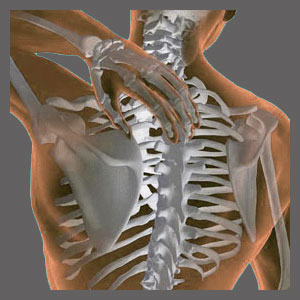
Spinal stenosis in the middle back is the least often seen variety of central canal narrowing. In fact, patients who suffer from thoracic spinal stenosis account for only a single digit minority percentage of all reported cases. The middle to lower thoracic spine is engineered for protection, stability and support. This area is not intended to bend or flex in the same manner as the cervical or lumbar regions. This natural design certainly spares the thoracic spine much of the age-related changes and disposition for injury suffered by all other areas of the vertebral column. However, when canal impingement occurs in the middle thoracic levels of the spine, terrible symptoms may result. Additionally, treatment might be more complicated, since few interventions are specifically designed for treating stenosis in the mid spinal levels.
This discussion focuses on stenosis in the middle thoracic backbone. We will detail the common causes of these canal narrowing issues and the reasons why treatment may prove to be particularly challenging.
Causes of Spinal Stenosis in the Middle Back
When discussing the middle back, we are specifying the thoracic spine from approximately T5 to T12. This area of the backbone does not undergo many of the degenerative processes that ravage the cervical and lumbar zones. The thoracic region also does not demonstrate the same incidence of injury as these other more mobile areas of the vertebral column. When stenosis does occur in symptomatic varieties within the mid to low thoracic spine, the cause is usually one of the following atypical sources of canal narrowing:
Congenitally narrowed canals can occur anywhere in the vertebral column and a small number do affect the middle back region.
Traumatic injury can affect any area of the spine. Serious injures can cause or contribute to central canal narrowing in the middle thoracic spine.
In elderly patients, the lower thoracic region is a relatively common site for compression fractures, particularly in obese patients and those with problematic bone density concerns.
Symptoms of Spinal Stenosis in the Thoracic Region
Most cases of middle thoracic stenosis will be asymptomatic, much like canal narrowing in other regions of the backbone. However, in severe cases of canal impingement, the spinal cord might become compressed at one or more thoracic levels. When this type of neurological constriction takes place, the following symptoms might result:
Pain might occur locally or may radiate to any region below the affected spinal levels. Many patients do not suffer any pain, despite having other significant symptoms.
Innervation problems can cause numbness, weakness or paresthesia in areas of the body below the stenotic levels. These symptoms can occur with or without the expression of pain.
Extreme cases of stenosis might disallow the patient from standing upright or walking. Other patients might have a tendency to fall down when standing or walking.
The worst cases of middle back stenosis might cause sexual dysfunction or incontinence of bladder and/or bowels, but these circumstances are rare.
Treatment for Spinal Stenosis in the Middle Back
Stenosis in the middle back is generally treated in the same manner as in any other region of the vertebral column. Conservative and moderate treat options will not change much, when compared to lumbar or cervical stenosis conditions. However, invasive surgical options might be more of a challenge.
Some stenosis surgeries require anterior or side facing incisions that can easily access the neck and lower back. However, when used on the middle back, some of these invasive methods of care increase in risk factors, since they must now contend with obstructive placement of the internal organs and rib cage. Furthermore, many of the surgical fixes for stenosis are geared towards the cervical and lumbar regions, which function quite differently than the middle thoracic spine. This can make some procedures and techniques less effective when utilized for thoracic stenosis.
The good news is that stenosis in the thoracic region has a far lower recurrence rate once successfully resolved using surgery. This is very good news for patients who risk it all to undergo invasive care, hoping that their suffering will be cured once and for all.
Spinal Stenosis > Thoracic Spinal Stenosis > Spinal Stenosis in the Middle Back





